Want to check out our tractor maintenance videos? Click here to see what we've got!
The Massey Ferguson 35 was replaced by the 35x towards the end of 1962 at serial number 302413. Many people will say that one of the differences between the 35 and the 35x is that the ‘x’ had differential lock fitted. However, here at VintageTractorEngineer we purchased a brand new ‘35 in 1962. We were given the option of diff-lock when we bought the tractor from Bruce Clayton of Gilberdyke, and so it is fitted to the tractor (which we still use on the farm today).
We recently saw one of these tractors sold at an auction.
Before the auction of this tractor a potential purchaser came to talk to VintageTractorEngineer to discuss some bubbling in the radiator. It looked like the symptoms of either a blown head gasket or a cracked block. The gentleman was eventually successful in buying the tractor, so a head gasket repair on this engine may be the next job for us (hopefully not a cracked block). £3,000 was the buyers limit, but he just couldn’t help himself and wanted to add the tractor to his collection!
If you have a repair to do on one of these engines then you may find our MF35 (3A.152) Engine Rebuild DVD helpful.
Comments….
1
Alan says:May 12th, 2008 at 3:26 pm
35 had no grease nipples in front hubs, slightly different cast of clutch peddel, different pattern pto lever, shorter leveling box handle, different dynamo bracket. Both 35 and 35x could have diff lock, both could have short mudguards though most x,s had them going down to footplates, the x was avalable with multipower. this is apart from the different cylinder heads and injection pump set up to increase hp from 37 to 44. Theres a ‘62 35, a ‘63 35x and a ‘64 35x here.These are the only difference I can spot on these tractors.2
Alan says:May 12th, 2008 at 4:59 pm
Sorry previous comment should read no grease nipples in hub caps, also the pull to stop is a slightly different set up on the 35x in comparison to the 35, just had a look at the 35x’s on our yard and both have the little triangular plates you point out as pre combustion chambers on your video, one of these tractors has been here since new and definatly hasnt had an engine swap, the 35 has them too whatever they are?3
The Vintage Tractor Engineer says:May 15th, 2008 at 6:06 pm
Thanks Alan for looking at your tractors and describing the differences. It seems as though I was wrong about the 35x engine – I will have to investigate further.Alan also tells us that the pto revs on the 35 is 1540 engine revs, but 1700 on the 35x.
4
Hamish Lowe says:July 16th, 2008 at 10:41 pm
The 35 and 35x were the same tractors except for the engines, both being indirect injection but the 35x operating at higher revs and with more HP and torque. Both had option of difflocks after serial No 283320, but only 35x had option of multipower which came as standard with diff lock. All tractors 35 and 35x after July 1963 had safety fenders fitted which reached down to the foot plates. It has been suggested to me that the 35x has a different dynamo bracket to the 35 and that the 35x has “GKN1523N” stamped below the dynamo, and above the sump.
Hamish5
Florence Sloane says:August 9th, 2008 at 10:22 am
I have recently purchased a 35X and I note that on the engine block below the injector pump there is a large number 09 on the block, also it has a long oil filter and I would like to know if this is a genuine 35X engine. The year of the tractor is unknown.6
Colin Taylor says:September 2nd, 2008 at 3:18 pm
Hello , to the best of my knowledge the 35 has the 3.152 engine, the 35x is the A3.152 which runs at higher revs and has a modified camshaft and injection pump.It still has the indirect injecton layout .The x engine having the dynamo bracket bolting directly to the timing cover (same as 135).It is 44.5 hp compared to 39 of the original 35. The 135 has the(AD3.152) engine ,with letter D meaning direct injection and has a very similar layout to the 35x except the direct injection layout and is rated at 45.5 hp at 2250rpm7
dave mckay says:September 5th, 2008 at 1:06 pm
also a difference i am told is that the 35 does not have an air pre cleaner intake through the bonnet is this true regards d mckay.8
niall robertson says:September 16th, 2008 at 6:19 pm
i had an early 3 cylinder 35 (1960) with the air intake through the dash but i also have a 1961 3 cylinder 35 with the air intake through the bonnet – but it is not a 35x.9
Damon Ross says:November 23rd, 2008 at 12:55 am
My Grandfather had a 35X and I learnt to drive on the thing.I recall it had a 3 cylinder Perkins diesel.Terrific 3 point linkage.
It had a differential lock and Multipower.My understanding is that because it had the Multipower facility it was designated with the “X”.
I know that if the machine was turned off ,and ,was in gear it would roll;indicating a torque convertor drive used in conjunction with a standard clutch set up.It could not be roll started because of this.
Memory a little hazy but I believe that when switched out of “normal” mode the multipower allowed “slippage” between engine and wheels,rather than between wheels and ground,
for whenever that may be necessary.
Being a mechanic these days my guess is that the multipower lever switched a kind of stator assembly on or off changing the drive from a torque convertor to a fluid coupling and vice versa.
Can anyone tell me if my guess is close?10
The Vintage Tractor Engineer says:November 23rd, 2008 at 6:48 pm
Hi Damon,With the multi-power system there is one hydraulic clutch pack and also a ratchet/over-run type assembly. When in low multi the hydraulic clutch is disengaged and the drive goes through a pair of gears into the ratchet clutch which takes the drive to the gearbox. There is no engine breaking in low multi because of the ratchet clutch. When you move the transmission to high multi it locks up the hydraulic clutch and the hydraulic clutch gear drives another gear. Because the drive is now turning faster than through the low-multi ratchet clutch, this (the ratchet clutch) now becomes a free-wheeling device. It is for this reason that there is engine breaking in high multi power, but no engine breaking in low multi power.
This is also why if you are in high multi going up a hill and you depress the clutch pedal that whilst in gear no roll-back can occur because of the ratchet clutch. ie. both systems are locked together.
The hydraulic multi-power clutch is not torque converter, but is merely a multi-plate hydraulically operated clutch pack. The good thing about this is that there is no loss of power through to the gearbox.
The clutch is a conventional clutch and so is the 3 speed gearbox.
Hope you can understand this.

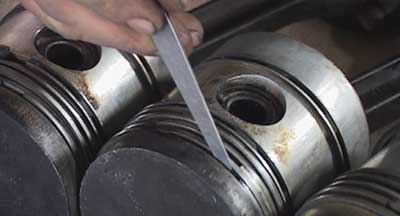
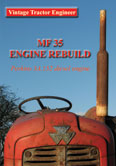
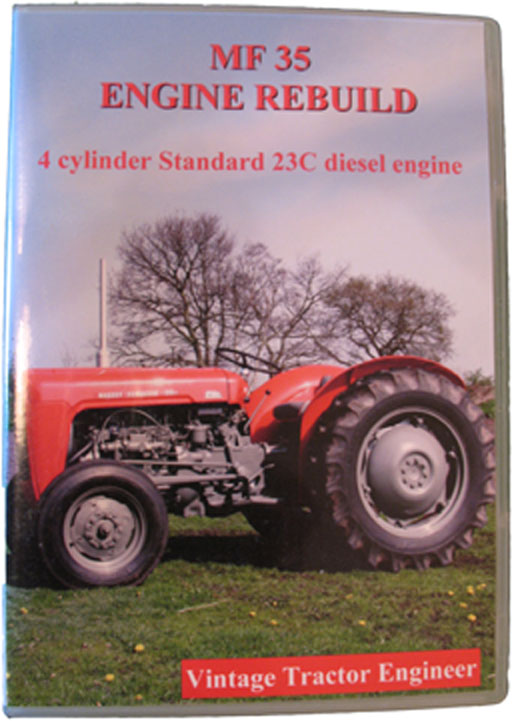
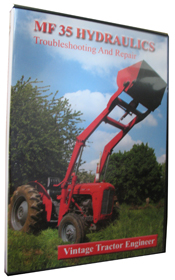
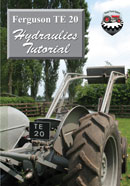
Hola tengo un massey ferguson 35x y deseo venderlo ,tiene documentación y esta bastante bien conservado, mando fotografías, es del año 1962.
I have a 1959 MF35 TVO. I would like to get the Zenith 28G carb serviced and up to spec anyone know who I can send it to?
Hi Simon,
There is the Narrow Width Tractor and the Vineyard model (so don’t get confused between the two).
For the Narrow Width Tractor…
Front wheel track is adjustable in 4 inch steps from 44 to 60 inches.
Rear wheel track is adjustable in 4 inch steps from 42 to 66 inches.
Turning circle is 18 feet (using brakes) or 20 feet (without using brakes) when front track is set at 42 inches and rear is set at 44 inches.
For the Vineyard Tractor…
Front track is from 37 to 58 inches.
Rear track is from 32 to 56 inches.
Turning circle on narrowest setting is 18’6″ (with brakes), 19’8″ (without using brakes).
For the Standard Tractor…
Front tracking is from 48 to 80 inches.
Rear tracking is from 48 to 76 inches.
Turning circle (48 inch wheel track) is 17’6″ (with brakes), 19’3″ (without brakes).
Steve.
I am looking to buy a MF 35. Can anyone tell me the difference in wheel width and turning circle of the standard model and the vineyard versions?
Thanks for the help
Hi
I have a MF35x the serial number plate is missing, is there anywhere else on the tractor where the serial number is printed or how would i find out, thanks a million
Ronan
Tenho um massey ferguson 35 x ano 1961 nao tem bloqueio,gostava de saber porque tem uma ligeira folga nas rodas de trás, será isto um problema grave? Gostava que algem me imformasse.
Obrigado
I’ve just taken the lid off the back hydraulics on my 1970 MF 135 multipower. I can’t get the auxiliary (multipower) pump off. I’ve managed to get the 2 bolts and the alan key bolt out which were holding it on. But the shaft through the pump is connected to a plate that joins the multipower to the hydraulic pump. Is there any way to disconnect this shaft from the plate or do I need to split the tractor?
I may sound like an idiot but what the hell is a dynamo?
TO 35 X 168055 is the serial number can anyone tell me the year built? What engine it is supose to have? it presently has gasoline. Looking to buy it. what is a reasonable price for tractor and loader.
I have a 35 ferguson that my great grandfather bought new. After his death it was passed to my grandfather. My grand father used this tractor until his death but he always had to roll start the tractor. We tried everything under the sun to try to get this tractor to start but never had any success. I now own the tractor and I am looking to renovate it. I would like to change the engine. After research I found that the engine is a Standard that is known for starting problems. I have found a 35 with perkins engine and was wondering if the engines could be exchanged. Any info would be great
I am looking for a 35x in need of a little work but not too much – nothing major! I have found one that had hydraulic brakes fitted (a single brake pedal in the usual place plus an extra long pedal either side acting directly on the normal brake rods adjacent to the rear axle to provide the independent brakes). The original hydraulic actuating system is now missing. How big a job is it to convert to the usual set up of twin brake pedals on the right hand side?
Mac
Hi Jim,
We haven’t got any data to cross reference the engine number with the serial number (maybe we should start and build a database).
Take a look at the bottom of this page… http://vintagetractorengineer.com/2010/05/massey-ferguson-35/
If you look for a casting code in the format explained on that page then that will tell you the month and year of production and you can go from there.
Steve.
Hi
I have what I think is a 35X with no serial plate 540pto at 1700 eng revs diff lock no multipower It has the following cast on the sump bottom 31 8 64 37171790 4DA 180 51 The number19E7956 is stamped on the block above the fuel pump L214 37111280 is cast on the block behind the fuel pump and GKN1523 is cast on the bottom of the block same side. On the gearbox casing clutch pedal side below the steering box is cast 894 882 M1 Is it possible to find the serial number from this information?
Hi Mike,
The explanation of the codes on the casings is on this page…
http://vintagetractorengineer.com/2010/05/massey-ferguson-35/
So I make your tractor a 1962.
Steve.
before anyone tells me that november only has 30 days I came up with november as from what I understand “I” was not used as it looked like 1, someone might know better
I have what I am sure is a 35x it has diff-lock and the A3.152 engine but no serial number it has a casting code just below the steering box “L 31 K” I am lead to belive that the first letter gives the month which in this case would make it november, the numbers give the day of the month and the last letter gives the year, can anyone tell me if this is the case and if so what year would K represent thanks Mike
I have a 35x the serial tag plate is missing is there any other way to determine the serial number
thanks Mike
i have sold the mf 35x multipower but should have kept it ,I would be happy to pay upto £5000 for another one and this time i will keep it ,please tel Rob Uren devon 01548521278
I am looking for a mf 35x multipower any condition but multipower must work fine tel 01548521278 rob uren devon top price paid
i have a nice 35x multipower i have decided to sell it is taxed for this year and i would like £5000 for it tel 01548521278 devon
Hi Joe,
The major advantage of diff lock is when one of the wheels has more traction than the other. A good example of this would be when ploughing in wet conditions – the tyre in the furrow bottom usually has much more traction than the tyre up on the top of the land. In this situation the tyre with the least amount of grip is the easiest to turn and therefore this wheel would spin rapidly and the tyre in the furrow bottom would not turn (with a tractor without diff lock). Diff lock can be used to lock these two wheels together, thus making use of the traction available in the furrow bottom and hence the tractor would now be able to pull the plough without spinning the wheels.
Steve.
just as a matter of interest, diff lock: makes both back wheels go round at the same time (speaking as a non-engineer)
so when’s this useful?
s=normal width
h=petrol standard (6:1:1)
m=dual clutch
y=differential lock
w=multipower
374061 was built in 1964
sounds like you have a MF35X to me, one of the last ones built 🙂
Hi there everyone. My friend has purchased a Massey Ferguson 35, it’s a 4 cylinder petrol engine. I am really wanting to know a little bit more about it, for example what year it was built etc. Or any more history about the thing. The serial number (i presume) which was on the ID tag next to the ignition is shmyw374061. On the foot brake side of gearbox we have the number 183253m5 stamped on it, also below that we have e27m. I hope some of this makes any sence to you, and any help or information would be greatly appreciated. My email address is b.k.herrick@xtra.co.nz
Thank you in advance for your help!
Regards
Kris Herrick
I am trying to use a rototiller on my TO35 and find that the ground speed is too fast.
Where can I find a Ferguson Epicyclic Reduction Gearbox and Live PTO Unit A-TE-118
Steve, Many thanks for the email re 35X. I have contacted Craig and await his reply.
Elizabeth
Hi Craig,
I’ve emailed elizabeth to let her know about your tractor.
Steve Ridsdale (VTE)
elizabeth. brook, we have a 35x for sale with a loader, muck fork and bucket. We are in Canterbury, Kent. Let me know if you are still looking. c_d_archer@hotmail.com
A Very hard working 35x The seal has been leaking into the clutch. Does anyone know how to remove the spindle/shaft as the pto gear is preventing me from pulling the whole lot out forward or backwards
please help
cheers in advance
Lindsay
Hi, I’m looking to buy a 35X for my husband to renovate , we live in France but will travel far and wide to collect for the right machine.
Anyone out there have one for sale ? Elizabeth
Hi Nick,
I’ve posted your comment to the homepage, to see if anyone has any information to help you.
The post will go out to the website subscribers, so lets wait and see if we get any response.
Here’s the link to the post about your tractor.
Regards,
Steve.
Happy New Year All, My lovely wife bought me a MF35X with 9 attachments in a job lot and now tinkering with my main “Toy”, I cannot positively ID it as either an MF35 or MF35X. Issue now is, tacho cable is missing and I’m trying to get the right parts. The output end is off the camshaft that is a 1/2″ shaft with a 3/16″ slot as if to take a flat bladed tacho cable end. Yet the ‘new’ supplied part has a 2mm sqr section each end. There is now confusion as to which engine I have. To solve the problem, the experts supplied a tacho drive shaft which is a small fitting comprising a small rod with a 3/16” slot, drilled through with a 2mm sq section hole. The end of this item has milled flutes as if to slot into the end of the camshaft. However, there is no way I can install it into/onto the existing camshaft end. The Engine S/N is 11229031 (too many numbers?) stamped on the rear end of engine block and also stamped on lower LHS of the block. Beneath the rear end serial number is stamped MDA DE91. Cast into the block on the lower LHS is GKN 1615 (no following letter). I have often assumed that many older engines have a country of origin letter incorporated within the S/N or casting number. After reading your great forum, I can also advise the tractor HAS grease nipples in the front hubs, HAS diff lock, HAS pre-combustion chambers, HAS small rear mud guards, HAS 1700 RPM as the PTO speed (540), HAS head lamps low on either side of bonnet, HAS a changed dynamo bracket, but does not have Multi-Power. Dash has ammeter, tacho and oil pressure gauges. What engine/tractor do I have? Cheers, Nick, Pelverata Tasmania. Oz.
I am looking for an engine block replacement for an MF35X. Can anyone help.
Hi
I want to buy a 1960s MF for occasional use and been offered 2
1. A 1966 MF 135 ground up restoration
2. A 1962 MF 35X, good restored condition
Any advice?
Many Thanks
John S
Hi Les,
The rod doesn’t enter the pack, it enters the control valve. It is possible that the valve is leaking. But also when the multi-power is shifted to high it directs oil from this valve through the gearbox input shaft housing, which then travels through the hollow drive shaft into the solid drive shaft. It then travels through drillings in the solid shaft to the hydraulic clutch piston (where it puts pressure on the clutch plates). Therefore it is possible that the oil is leaking between any of the shafts and their housings and discharging into the clutch housing. BUT, the input shaft housing is equiped with a drainage system to catch any leaks which occur and then return them back to the transmission oil reservoir.
It is more likely therefore, that the control valve (or its supply pipe) is the source of the leak.
So there’s no choice but to split the tractor and have a look (you may be able to see with a torch, looking through the bottom plate).
Hope that helps,
Steve + Ian, The Vintage Tractor Engineers.
I have a 35X and it is leaking oil from the drain at the bottom of the clutch housing. The machine has been driven mostly in high range on the multi power and leaks more in this position. Is this caused by wear in the rod that operates the multi plate hydraulically operated clutch pack. If this is so could you please tell me how this rod enters the pack.
Thanks for the help